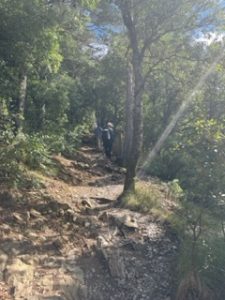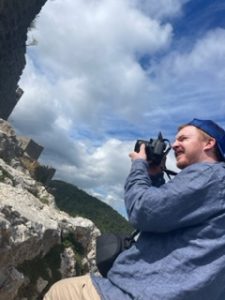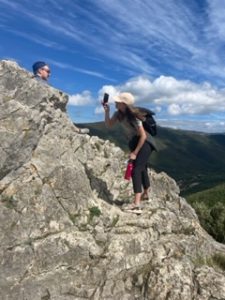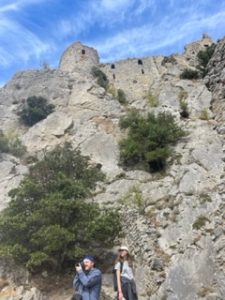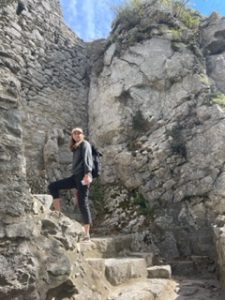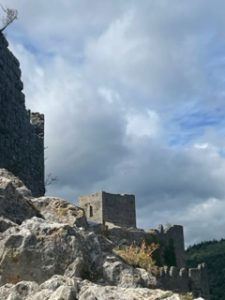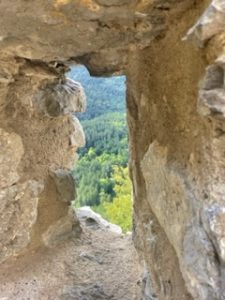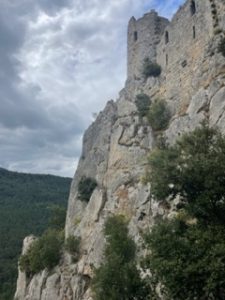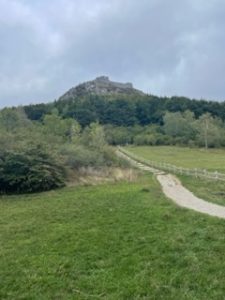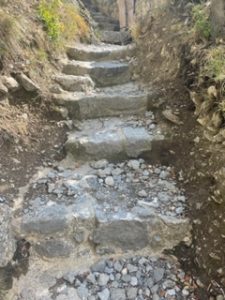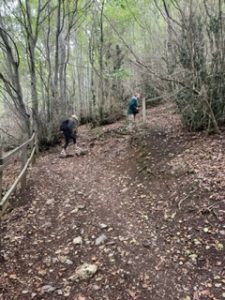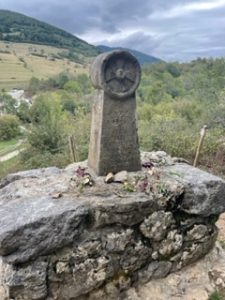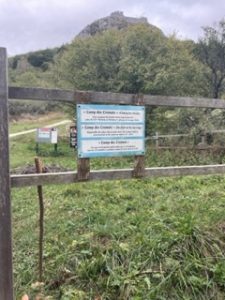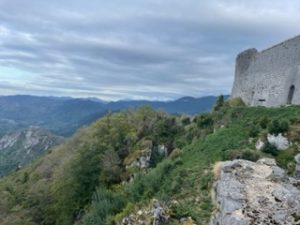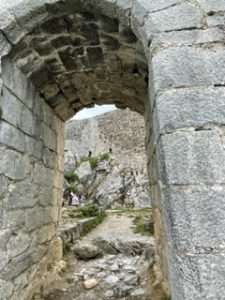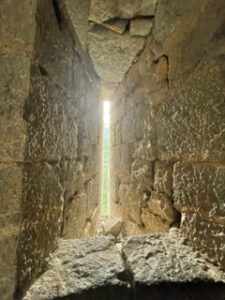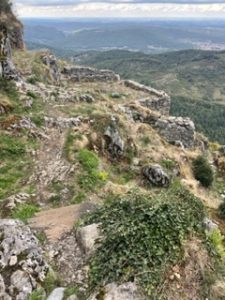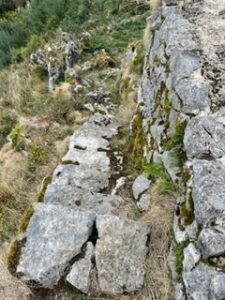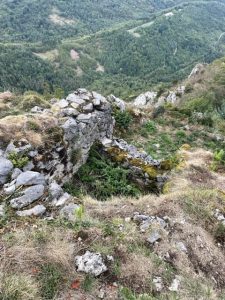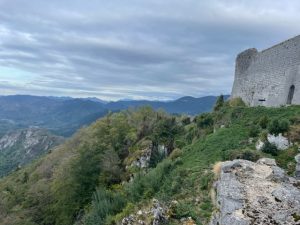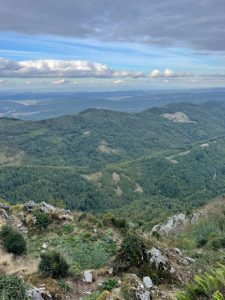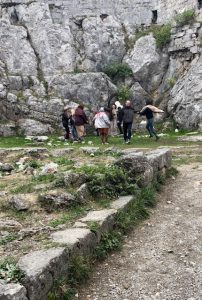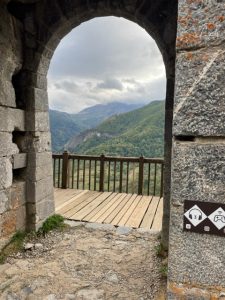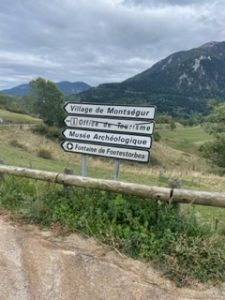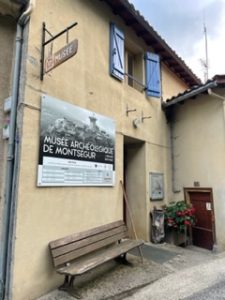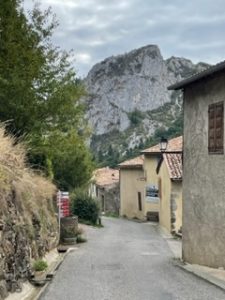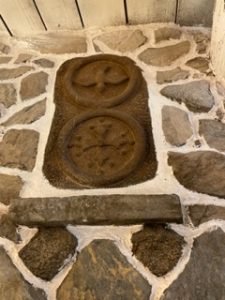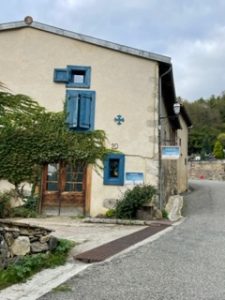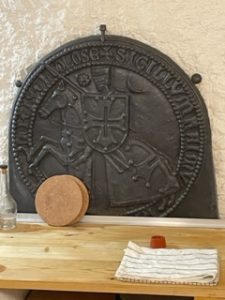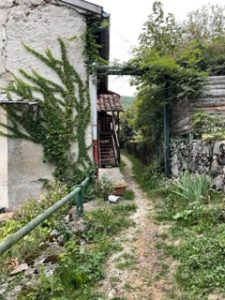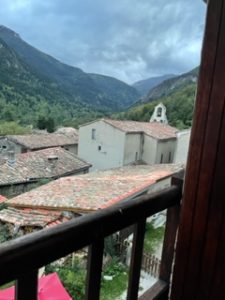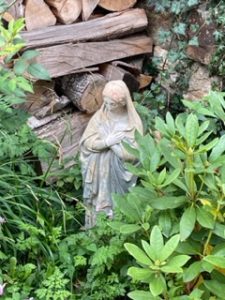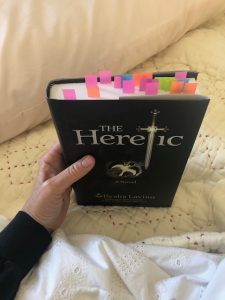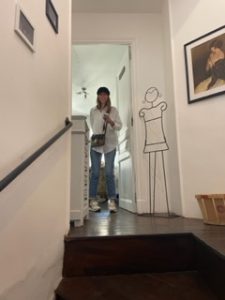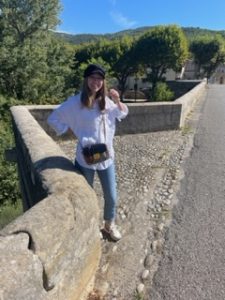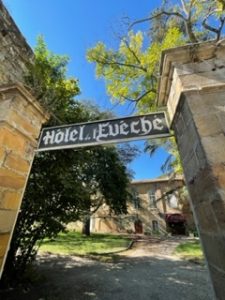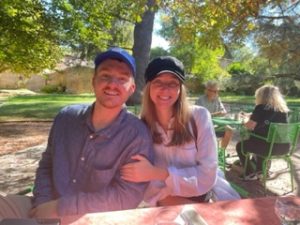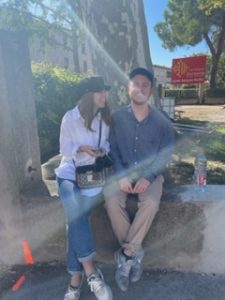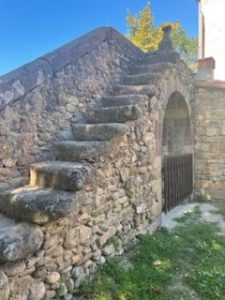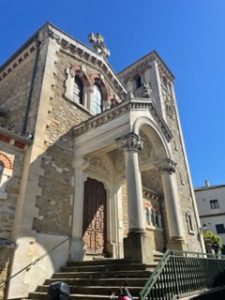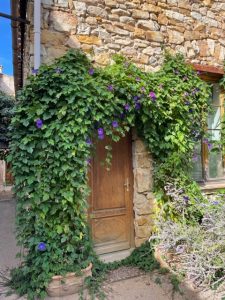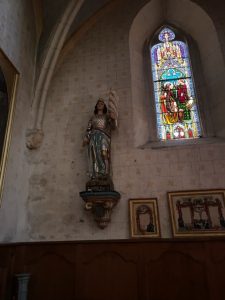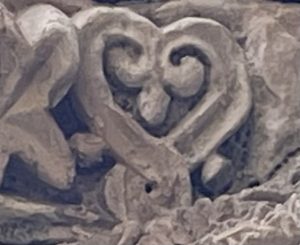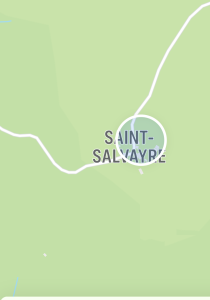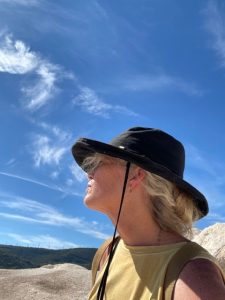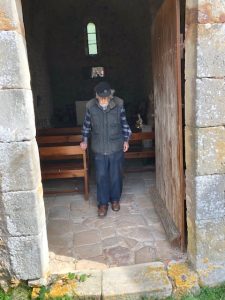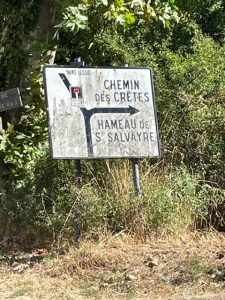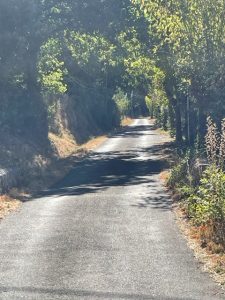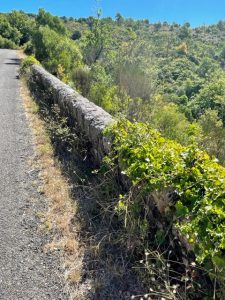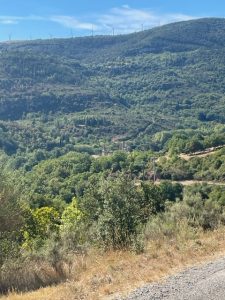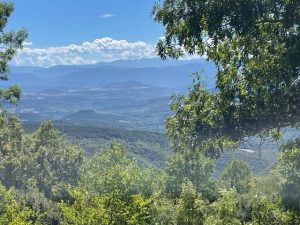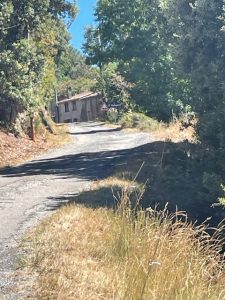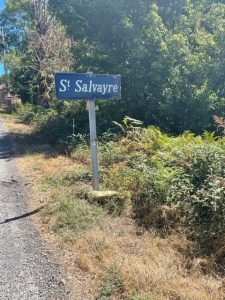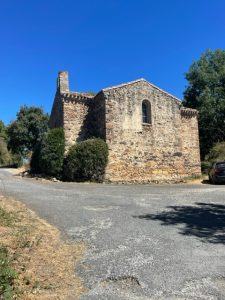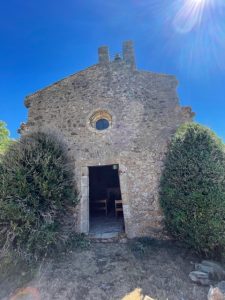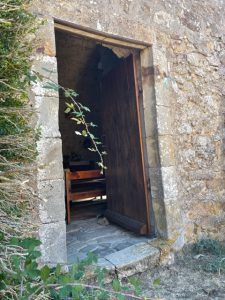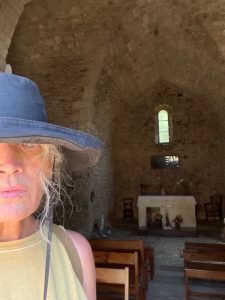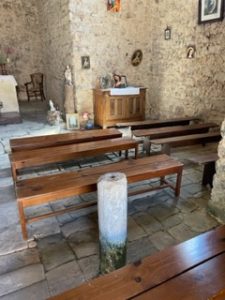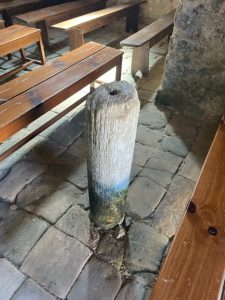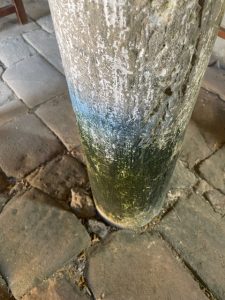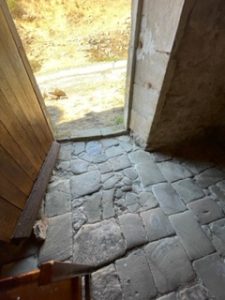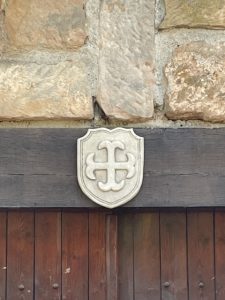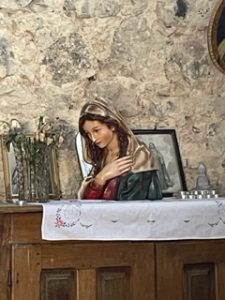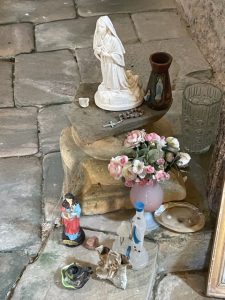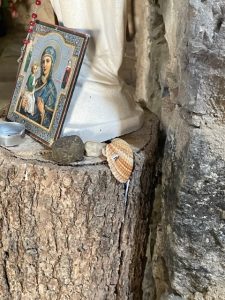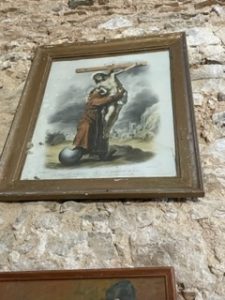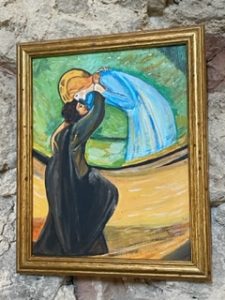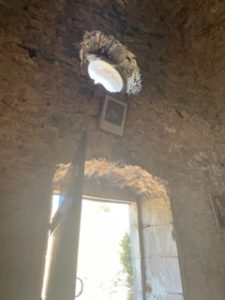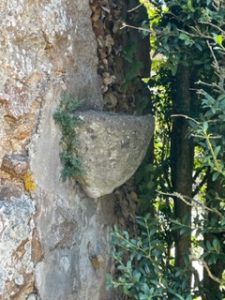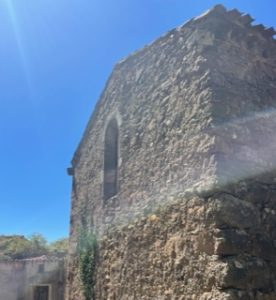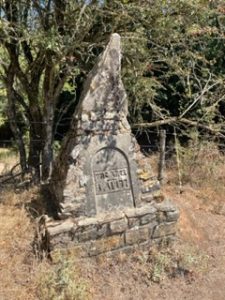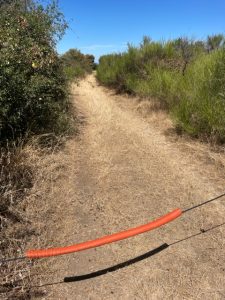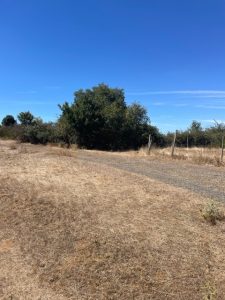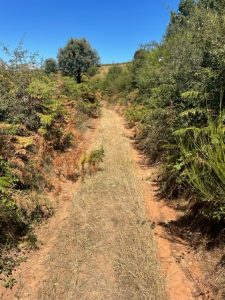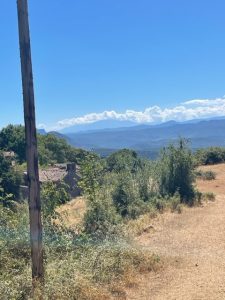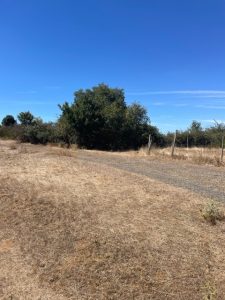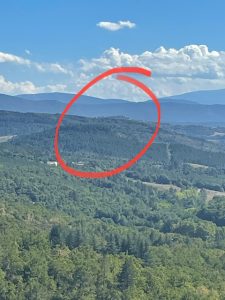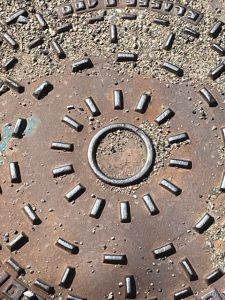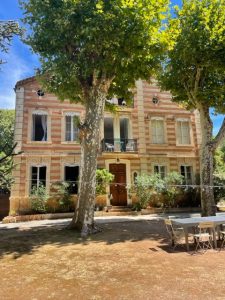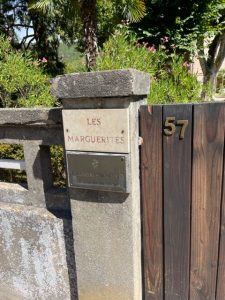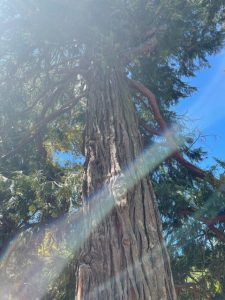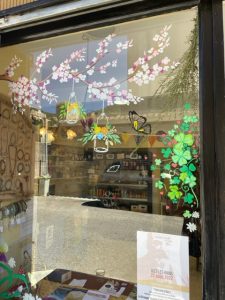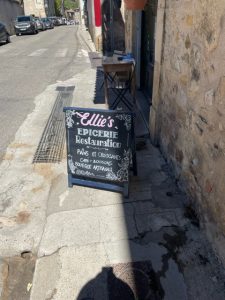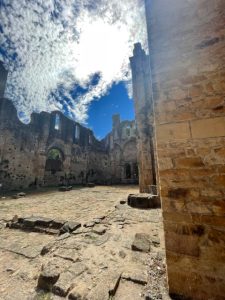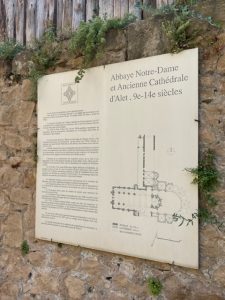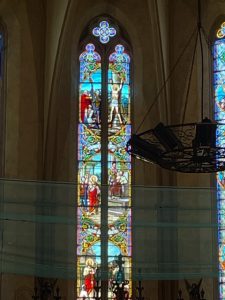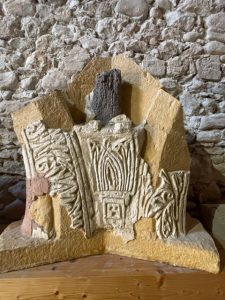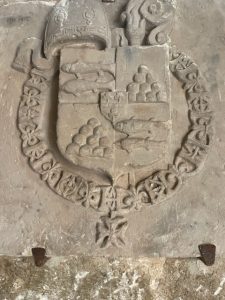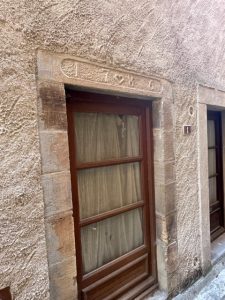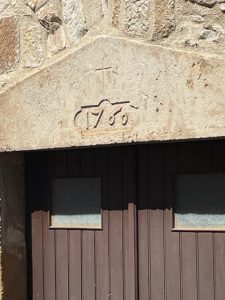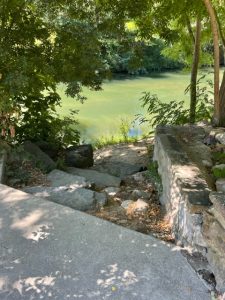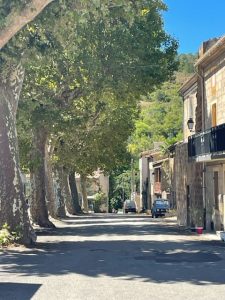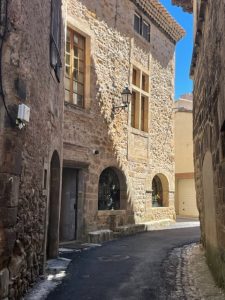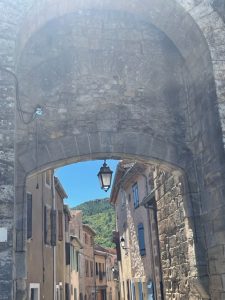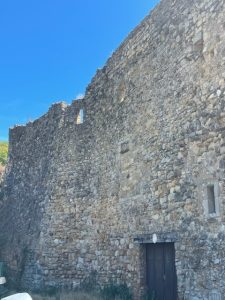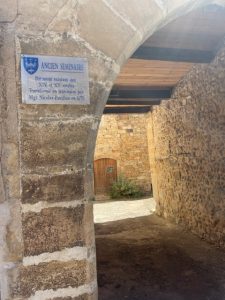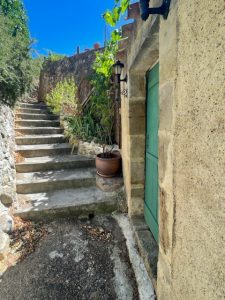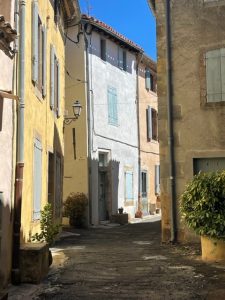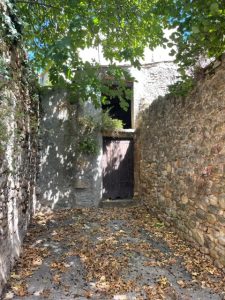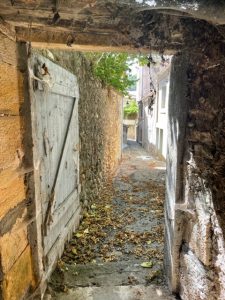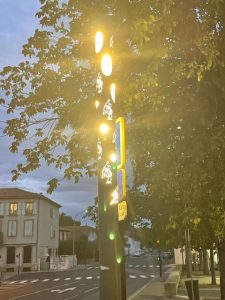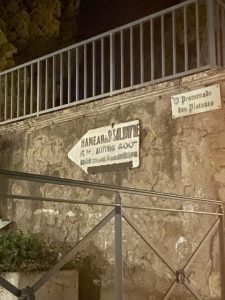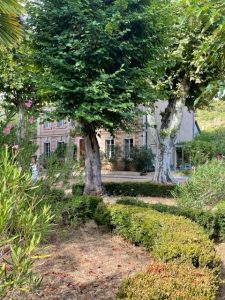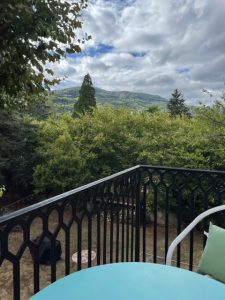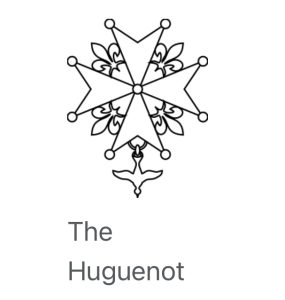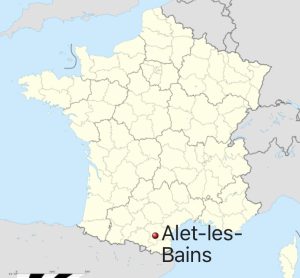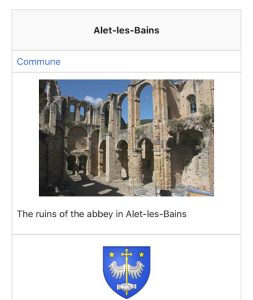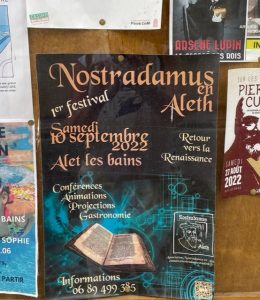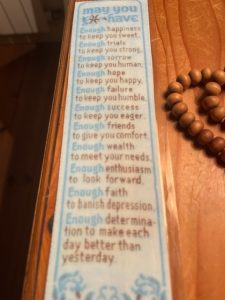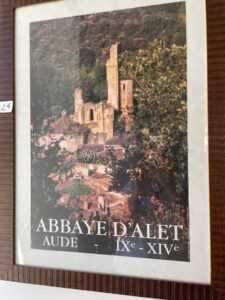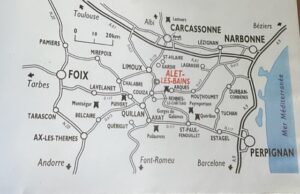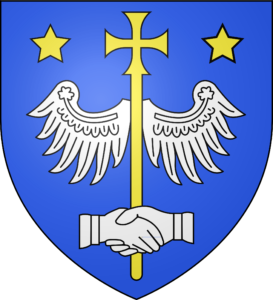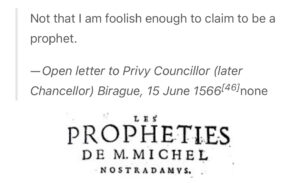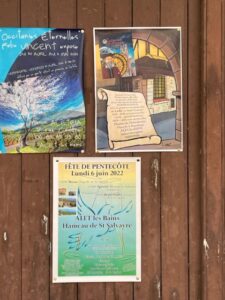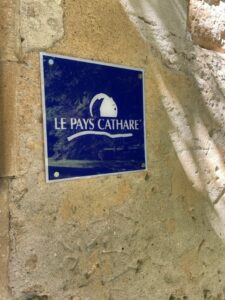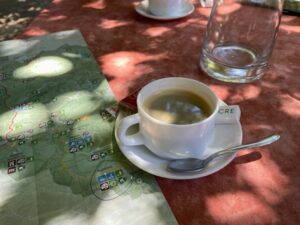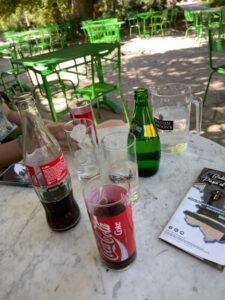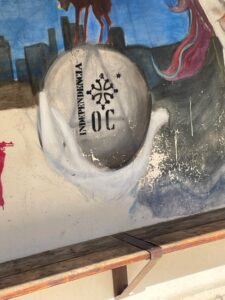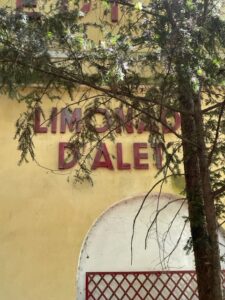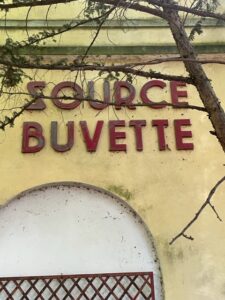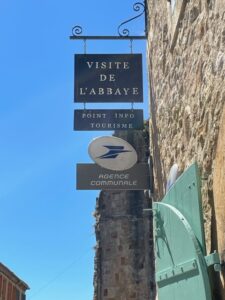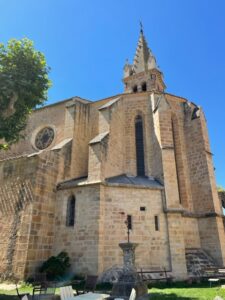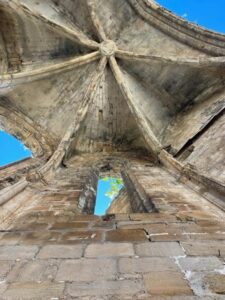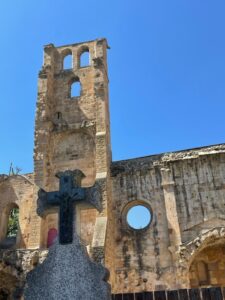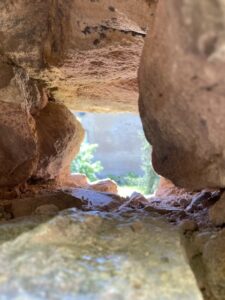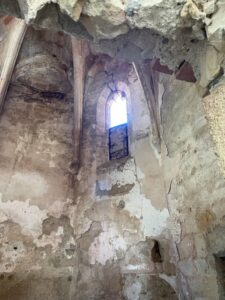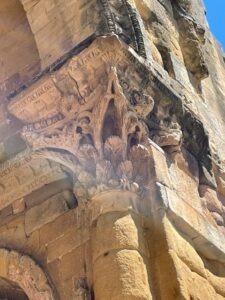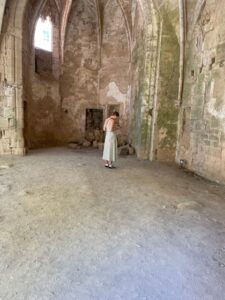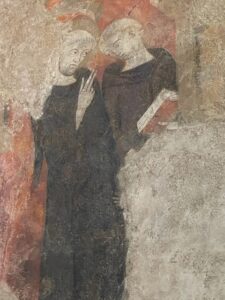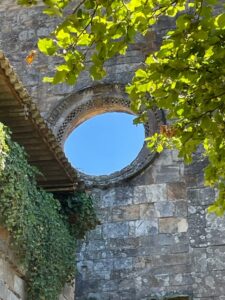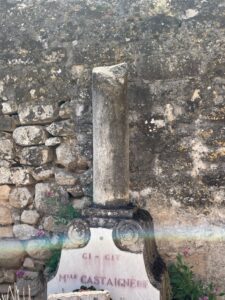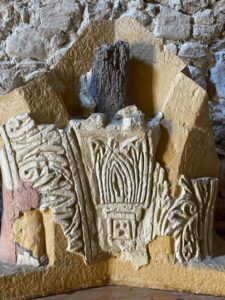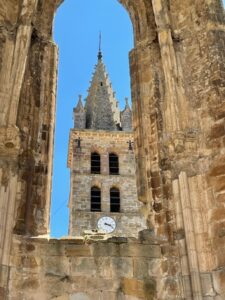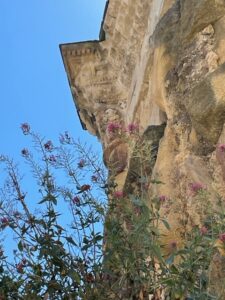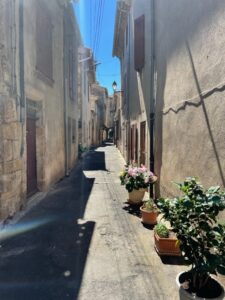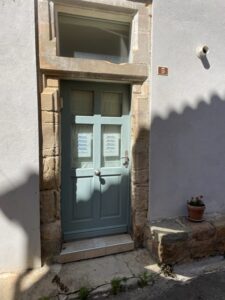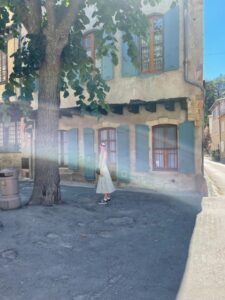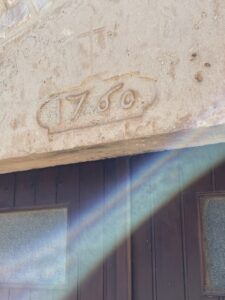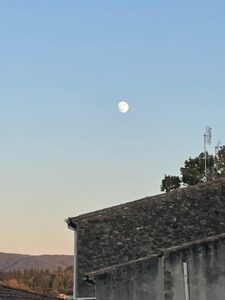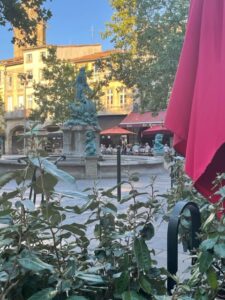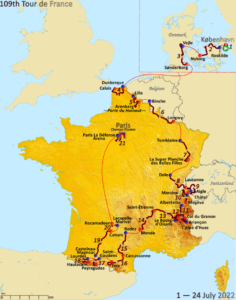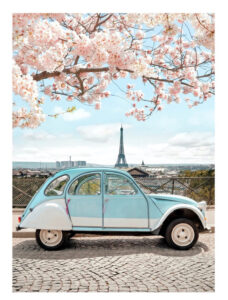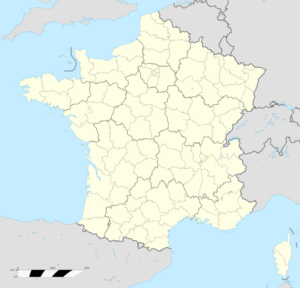Alet-les-Bains
Dayle in Limoux – Day #82
September 26, 2022R O A D T R I P ❗️
French Villages, castles, and an amazing memory in Montsegur at La Maison Sous le Château. Manual Citroën is the best. Always secure the smallest car you can and practice accelerations. :)
Puilaurens
‘Immerse yourself in the medieval atmosphere of Puilaurens Castle, an impregnable fortress in Cathar Country, at the top of the sheer rock face. The walls and towers have been marked by time and are filled with history and legends. Can you find the “secret” passages leading to the giddy panoramas?’ We did!
[https://www.visit-occitanie.com]
Beginning the hike up to the castle ruins…
Annie Glenn in awe and loving Languedoc.
Michael inspired on his first journey out of the United States and ready to return.
The Square Tower dates from the time of the Crusade against the Cathars. The so- called “White Lady” Tower, where Blanche de Bourbon, granddaughter of Philip IV, was reputed to have stayed on her way south to her ill-fated marriage with the cruel Peter of Castile, has a duct through the wall that acts as a speaking tube.
Aged just fourteen in 1353, after three days of marriage, Peter abandoned her in favour of Maria de Padilla, imprisoning poor Blanche in various places in France and Spain, until the age of twenty two, when he had her murdered. Legend has it that when mists surround the castle, Blanche is wandering the walls in her misty veils.
https://anglophone-direct.com/cathar-country-chateau-de-puilaurens/
Montségur
Montségur Castle is a fortress built on the ruins of a previous Roman settlement in the Occitanie region of Southern France. In 1204, Raymond de Péreille, the Lord of Montségur, decided to rebuild the Castle which had been in ruins for 40 years. The refortified Castle immediately became the epicentre of an important Cathar community. Catharism was a Gnostic movement which deviated from the teachings of the Catholic Church and which spread like wildfire in the 12th and 13th centuries. Amongst other tenets, the Cathars believed that Jesus was not the son of God but merely an upright prophet and scholar. They believed that men and women were both essentially equal and that money and physical trappings were not important in life. Even though they lived lives of poverty, it is believed that the Cathars amassed great riches, since many members, who were people of ‘substance’, donated their property on joining and many well-wishers and patrons donated money to help the cause as well. On the other hand, at the time Pope Innocent III, as well as the Kings of England and France, were struggling with financial difficulties caused by investments in the Crusades in the Holy Land. A theory states that this was one of the main reasons why the Cathars, a peaceful Order, were branded as heretics and hounded to their deaths with such cruelty, even prompting the setting up of a special Inquisition for such a purpose. At the time, all their assets and lands were seized and divided between the Pope and the King of France during what became known as the Cathar Crusade or the Albigensian Crusade. Whole cities and villages were destroyed by the Inquisition, which targeted both nobles and peasants alike. Ironically, the supposed ‘treasure’ of the Cathars was never found, or at least, no one has reported its acquisition.
https://castles.today/en/france/montségur/legends/
The hike up…
…and reverence for the bon hommes and bonne femmes who were murdered in the pyre because of their beliefs, and the greed and evil of Pope Innocence III.
From the book, The Manuscript. ☉
The Cathars considered themselves to be the true Christians. Part of their learning rested on primitive Christian, Gnostic, Jewish and Islamic ideas, which at all decisive points different from the Roman Church.
The daily bread was for the Cathars the spiritual bread, and both women and men could become priests, perfect, in their community. The Cathar movement had wide support amon the Languedoc population and when this support tended to spread to all of France the Pope, Innocence III, sent a monk, Bernard of Clairveaux, to preach against the heretics. He saw, however, that their services and morals were far more Christian than those of his own corrupt Church. He also admitted that he could find no fault with the parfaits of the Cathars. They only practiced what they preached. This was not to the liking of the Pope and thus he implemented the crusade resulting in the massacre of Montsegur.
[…]
‘A common legend which had been retold for generations by the descendants of the Cathars, was told by a shepherd from Montsegur as late as 1929:
“When the walls of Montsegur were still intact, the Cathars, the pure ones, guarded the Holy Grail there. Montsegur was in danger. The armies of Lucifer lay in a circle around the walls. They wanted the Grail, so that they could mount it in the emperor’s tiara, from where it had fallen to the ground when the angels were banned from Heaven. When peril was at its highest a white dove descendde from Heaven and split the mountain in two with its beak. Esclarmonde, the female guardian of the Grail, threw the precious, holy treasure into the mountain. It then closed again. In this way the Grail was saved. When the devils forced their way into the fortress, they were too late. Filled with anger they burned all the pure ones at the foot of the cliffs under the fortress on the camp des cremate, on the field where where the state was built.”
More than 200 hundred Cathars, men, women and children, chose by their own free will to be burned at the stake. According to an oral tradition, they had promised to return after seven hundred years [pp. 39-40].’
In memoriam at Montsegur.
Ani Williams is world-renowned harpist and singer, and has recorded more than two-dozen albums of original sacred music based on ancient spiritual traditions.
The back side of the castle ruins where remnants of the Cathars living quarters and community gathering sites for work and living.
Folks honoring the Cathars at Montsegur with dance and song.
Then in the chill of fall and winds, it was time to head back down, imagining…trying…the 200 + Cathars holding hands and singing their hymns as the fires from the pyre burned below them and their wicked fate to a tortuous death.
R E X M U N D I
Evil forces always swirling about.
And then it was a short drive down narrow lanes to the Village de Montsegur to stay the night at La Maison Sous le Château. Sadness. The museum was closed. Next time. So wanted to visit.
J’adore the village of Montsegur, almost as much as Alet-les-Bains and Limoux.
Cathar crosses everywhere and history whispered in the winds.
Up the stairs to our private room and bath and a warm meal with local vegetables, soup, pain, and vin…
…at the foot of the Pyrenees.
You must stay with Fred and basque in his warmth and hospitality, his cooking (!), as well as his knowledge of the Occitanie region, the Cathars…and Mariam.
I wanted to linger longer in this ancient village in Southern France.
Can’t wait to return. Thanks be to Gaia.
You must read this book!
Car returned and ready for a very hot bath. Fall has landed in Languedoc.
Bonne nuit.
♥
Dayle in Limoux – Day #78
September 21, 2022V
O
T
E
Always. Now. Especially. Register.
Thank you, Valerie Kaur.
“All our votes together? A R e v o l u t i o n.”
There’s my girl (!) back in Limoux doing her virtual work and exploring Languedoc with her maman. ღ
The bridge into Limoux with her guy.
Lunch in Alet-les-Bains!
Michael and Annie in Alet-les-Bains at L’Eviche for lunch under the trees and the abbey.
Waiting for the bus. Always. :)
A peek at the bridge and some random ancient stairs, most likely to connect to an old rampart. So want to know their story…
Found another old barn in Alet.
Great structure.
And another great find in Limoux. An old church from about 780 C.E. Beautiful.
Roman architecture.
I miss you William Henry.
B
E
L
I
E
V
E
Bonne nuit.
♡
Dayle in Limoux – Day #75
September 18, 2022by Suleika Jaouad
‘…but I’m still yearning. It’s different now, in that it’s not specific things, just the word: more. That’s the bittersweetness of being granted your wishes, then facing the prospect of losing them. I love my life—my family, my husband, my sweet new dog, my friends, my home, my garden, my work, and this beloved community—and I want to be able to enjoy that life, today and tomorrow and for many years to come.
But with this illness and all the treatment side effects, I can’t rely on my body from hour to hour, much less day to day or week to week, which makes planning or making commitments so difficult. It’s strange to have a sense of urgency to make and do and see, but to also have a body that often just can’t. It’s a particular kind of entrapment.
So here at the beginning of fall, instead of embarking on some grand adventure, I’m rejoicing in the moments where I can enjoy a small one. One day last week, while out at my farmhouse, I woke up feeling… well, feeling like I hadn’t just consumed a dose of rat poison. I have two electric bikes, and that afternoon, my friend Kristen and I hopped on and started speeding down the winding country roads, past babbling brooks, under covered bridges, up into the hills. After awhile, we stopped at a plant nursery with a little outdoor bar and lounge and had cocktails—something I hadn’t done in a very long time. By the time we left, the sun was setting, and I felt almost giddy. That afternoon, I’d had more.
[Alet-les-Bains in Languedoc, France.]
From Fr Richard Rohr, Center for Action and Contemplation.
Old age, as such, is almost a complete changing of gears and engines from the first half of our lives, and does not happen without many slow realizations, inner calmings, lots of inner resistance and denials, and eventual surrenders. All of them by God’s grace work with our ever-deepening sense of what we really desire and who we really are.
Reality, fate, destiny, providence, and tragedy are slow but insistent teachers. The horizon of old age seems to be a plan that God has prepared as inevitable and part of the necessary school of life. What is gratuitously given is also gratuitously taken away, just as Job slowly came to accept.
If we are to speak of a spirituality of ripening, we need to recognize that it is always characterized by an increasing tolerance for ambiguity, a growing sense of subtlety, an ever-larger ability to include and allow, and a capacity to live with contradictions and even to love them! I cannot imagine any other way of coming to those broad horizons except through many trials, unsolvable paradoxes, and errors in trying to resolve them.
The ripening of mind and heart is most basically a capacity for nondual consciousness and contemplation. So my guidance is a simple reminder to recall what we will be forced to learn by necessity and under pressure anyway—the open-ended way of allowing and the deep meaning that some call faith. To live in trustful faith is to ripen; it is almost that simple.
There she is. Johanne. Joan of Arc.
At Église Saint André in Alet-les-Bains.
L
O
V
E
It finds us.
Bonne Nuit.
ღ
Dayle in Limoux – Day #50
August 24, 2022✧ * . * ✧ . * . *
. * . * . m y s t e r y . ✧ .
✧ ✧ * . * . . *. m a g i c .
✧ * .m a g d e l a . ✧ . * . * .
The last time I visited Saint-Salvayre was before times, in the fall of 2019. I’ve been contemplating this day for so long, yearning to be here, pulled to being here. And as Sir Henry Lincoln (‘Holy Blood Holy Grail’) said to me that day inside the church as he was sitting quietly next to the ancient standing stone, “This is a very special place.” I captured Henry as he was leaving the church in the small hamlet of Saint-Salvayre near Alet-les-Bains.
Sir Henry died this year on February 24th. He was 92. How I wish I could meet up with him where he lived at Rennes-les-Bains and talk all things Mariam of Magdala and her journeys with Yeshua in the Languedoc region of France. I have so many more questions and perspectives to share. More than that, just to listen to him speak of this history, where ever he chooses to take the listener. “Don’t look, see.”
When I visited this tiny, ancient church/Roman resting place on my first visit, we were in a small van. I had no recollection how vertical! the journey was. I remember reading recently about Roman garrisons lighting fires in St. Salvayre to alert chateaus in the surrounding area thinking, how could they see it, it is not very high. And when I heard people drive up to the hamlet to watch the Bastille Day fireworks being displayed in Carcassonne, I thought, but isn’t that high, so maybe the open space? Now I know. The views of the Pyrenees are spectacular; just the general splendor of the entire region is on display on the long hike up. The path is six kilometers from Alet-les-Bains and it’s all vertical. I read recently where someone had shared it was a ‘comfortable hike.’ My take? A little different. Some thought processes today in the 95 degree heat…going up.
Starting point: If I lived here, I could climb this every morning for prayers and meditations.
1/4 way up: maybe once a week.
1/2 way up: maybe twice a month.
3/4 way up: maybe just once a month.
Almost there: definitely need a Vespa.
Seeing the sign…f i n a l l y. So happy.
And then, there it is.
Pausing, reflecting, and centering before entering.
Gratitude and grace for surviving the plague and being given the gift of returning to this sacred and magical place, Saint-Salvayre. Indeed, as Sir Henry shared, a very special place, from the shrines to Mary Magdalene, to the painting of Yeshua, still living, being helped from the cross by St. Francis. The messages, the meaning, and the mystery. It’s all of it: the history, the sacred geometry, and the ancient standing stone, where it seems the structure was actually built around.
The stones, the shapes, their placement, all speak to ancient Roman times. Where this structure is placed could once have been a pagan place of worship. Then, in later centuries, a new structure built in the shape of St. Andrew’s cross. The Templars were reportedly here (Baphomet), and it was a place of refuge for Cathars.
Cathar cross.
And here, a shell. Was this left by a pilgrim on their way to the Camino de Santiago de Compostella?
A small ancient water basin outside the door of the church discovered behind thick foliage.
A marker outside of the church, just up to the left. The markings look Greek, or Egyptian. I haven’t been able to locate any information about this stone piece.
I tried to locate the twin trees and other standing stone about 1.5 kilometers away, but couldn’t find it this time. It’s been three years and there’s so much undergrowth and with COVID, very few visitors. I really tried.
I don’t remember the barrier there; climbed over.
By then, my feet were hurting so badly from the climb…blisters.
So after one more repose inside Saint-Salvayre, I started the climb down, grateful to use a different set of leg muscles, although my poor pieds, pas bon.
I stopped at one point on a hill of natural limestone to find Rennes-les-Chateau in the distance…sacred geometry.
Light. It’s everywhere. We just have to see.
I loved today.
Bonne nuit.
🔆
Dayle in Limoux – Day #49
August 23, 2022Being in France.
❀
I know. Nothing to do with France, right? But it F E E L S like this.
´*.¸.• .¸. ❥¸¸.☆¨¯ℒℴve.¸.¸¸.☆¨¯`❥
Exploring Alet-les-Bains today after a beautiful breakfast in the garden at Les Margarites with Antoinette, the proprietor. A lovely conversation weighted too heavily with all my questions.
Les Marguerites in Alet-les-Bains. It sat empty and unloved for 50 years. During WWI it was used as a convalescent home for veterans. Prior to that it was a holiday home for many who came every summer. Some have returned just to see it, with fond memories from their childhoods. Antoinette and Keith have owned it for 15 years now, raising their four children here. The trees in the yard deserve a historical plaque of their own. Majestic and magnificent.
Here’s a link to their website. https://www.les-marguerites.fr
The grass is brown from the extreme heat and the proprietors aren’t wasting precious water to grow it back. Letting it be.
The population in Alet is about 249, decreasing since the 2015 census. It somehow feels ‘bigger’ walking through the medieval streets. Spotted a tiny market today that the community pooled together to have some needed supplies for those who can’t make it to Limoux.
There’s a tiny post office at the tourist /abbey office. And had to go back to the abbey today, too. Original structure, most likely pagan, from the 800’s.
And in the church next to the abbey ruins, interesting stained glass. Typically, although this method of crucifixion was used as depicted, it isn’t the way Yeshua is depicted being crucified.
Église Saint André is the name of the church in Alet still being utilized for worship.
And images from the village…
River L’Aude.
Love this capture of the ancient fortifying wall, many sections still standing. Very little renovation can occur in this medieval village without the proper permission, especially to the exterior of buildings.
And found an old barn for sale!
Yep. A barn in france.
Demain. Tomorrow! The tiny hamlet of Saint-Salvayre.
Bonne nuit.
❁
Dayle in Limoux – Day #48
August 22, 2022Leaving the lights of Limoux for the village of Alet-les-Bains. J’adore. The history, the energy, the healing water, and St-Salvayre. Hiking there this week, about 5 km away from the village. Last there in 2019, ‘before times.’
How will it feel this time? So much more knowledge since my last visit. Part of the sacred geometry, and the Roman road between Alet-les-Bains and Narbonne. Mary Magdalene traversed these roads in France.
Les Marguerites, where I’m staying while in Let-les-Bains. Tellement jolie. I’ll take lots more pictures of the village tomorrow.
Isn’t this a great symbol? Still used today by protestants in France.
The Huguenots were a protestant sect who numbered about 2 (m) in France circa 600 years ago. They burnt the Abbey here at one point because, you know, Catholics. Seriously, we should have stayed with Pagan worship…the sun…the stars…the earth. We’d be in a waaaaaaay different place now.
The best flag in Alet-les-Bains. 💛
Andandand…guess who lived here at one time for awhile?
Oui! Nostradamus! I’ll be at the Faire la fete on Sept. 10th. :)
And, a sweet message from the bed-side drawer in my lovely little room.
..•*¨`*.•
´*.¸.• ❥❥ Bonne nuit. .¸.
Dayle in Limoux – Day #7
July 11, 2022Alet-les-Bains
The abbots succeeded each other at the head of the abbey until 1318, when Pope Jean XXII established the abbey in the Eveche. The abbey then became St. Mary’s Cathedral and Abbot Bartholomew became the first bishop of the Cathedral.
In the sixteenth century, the Wars of Religions will be right in the abbey of which there will remain only ruins. [aletlesbains.com]
Lunch at the Hostellerie de l’Eveche, under the massive ancient trees with my girl. Eased the early afternoon with exceptional food and carafes of fresh water in the 98 degree French heat [36 celsius].
So
H
O
T
and so fun. To be back in my beloved Alet-les-Bains with Annie, showing her the history and ruins, the bells of the abbey, walking the medieval streets overtaken and occupied by the Nazis, the once walled city stands in tribute to the ancients and inquisitions that enfolds the village of 500 with energies and mysteries. After walking and exploring for hours, we needed fluids. Lots. Back to l’Eveche for l’eux, French Coca-Cola (our bodies were craving Coke, just like when in India), and Perrier, too. I think I was actually sloshing when we left. It helped. Then back to the main highway to catch our return bus to Limoux, where we bought more l’aux at the local market! :)
We toured the historic hotel, La Belle Aude. It was for sale three years ago, not sure of the status now.
L
O
V
E
At the hotel there’s an old lemonade factory and thermal baths discovered by the Romans, using the healing waters of the community. So many ideas and marketing possibilities to buy and renovate the structure, for writers-in-residence and Cathar/sacred geometry mystery tours and study. It edges the River Aude under beautiful massive trees and ancient Roman baths.
Touring the abbey with my girl and absorbing the history, the faded blues, reds, and greens of the centuries old frescos. Indelible. As the massive deep bells rang we imagined the religious wars and destruction. Some captures to share from today.
Studying the history, imagining the people and the conflicts as they tried to practice their beliefs and live their lives in peace.
A standing stone as a grave marker in the ancient cemetery. Remarkably old.
Walked some more around the medieval square. J’adore every cobbled street and stone.
Yes, please. :)
Annie’s favorite. ♡
Depleted from the heat and leaning toward the time our bus would return, we headed across the fortified bridge out of the beau village.
And then this evening from the balcony at 22 Maison, la lune approaching fullness as the swallows murmur and the frantic ducks make their demonic noises. (“Are those really ducks?”)
Full Moon in Capricorn is Wednesday, July 13th
Known as the Buck Moon, this is also a super moon amplifying whatever it is casting its light on. If you have unfinished business or unresolved issues, they will be illuminated with this full moon. The good news is there is lots of support and many helpful allies that can assist you in sifting through the chaos and instability to find and anchor your inner strength and truth. You will need to practice trust and positive, practical resilience if you are facing challenges. Ask for help and be willing to accept and receive what shows up.A full moon always provides a portal or opening for expansion, gratitude and celebration of what you have, what you have accomplished, and what your future dreams are. Take some time to be with gratitude, beauty and whatever inspires you.
Dayle in Limoux – Day #6
July 10, 2022Sunday evening in Limoux.
H
O
T
!
The Tour de France is going to be tough next week. The heat wave returns with 100+ days. The Tour will be in Limoux on Tuesday, July 19th. Can’t wait! Look for me. :) This is a tough year on the stages and with the heat? Pas bon.
My new dream car.
Some day. With my renovated barn.
Tomorrow, Alet-les-Bains!
Alet-les-Bains was once a walled city with its own abbey – and later its own bishop and cathedral. In 1197 the abbey and the town were fortified by ramparts and a moat. Now it is little more than a village of just over 500 people but you can still see vestiges of the city walls and ruined Cathedral. In 813, Alet was the seat of a Benedictine abbey founded by Béra, Viscount of Razés.
The people are so kind here. Thinking today it’s all we have left, really. Kindness. Leaders and politics, capitalists and dark money, profit and greed, systemic patriarchy, all reign in the collective. Here’s what we can do:
And save the planet. 🌏
❀

